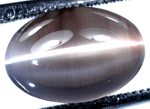India’s multiple gem producing wonderland – Orissa – is yielding another gem-quality colored stone which is highly valued due to it’s rarity: Sillimanite Cat’s Eye.

Sillimanite Cat's Eye
Some pieces of this rarity have reached museums and a few are treasured by proud collectors. These stones were never earlier available for commercial use in jewelry. They were previously found in Sri Lanka and Burma. The stone has a hardness of 7.0 to 7.5 and a specific gravity of 3.24. Now found in Orissa, the sharp cat’s eye producing gemstone is coming to the market in white, gray and black shades. This gem is very difficult to manufacture due to peculiar characteristics of layering out while shaping – a unique condition that causes the yield and the size of stones to be very low. These cat’s eye cabochons may be required to keep a slightly heavy bottom.
When this correspondent visited Orissa to observe the site where people are exploring, I found that most of the material coming out was very small in size — which ultimately is wastage. The cat’s eye cabs for commercial use are available up to 5 carat pieces only. Sizes from 5 cts. and above may not be enough for collectors and museums. At the time of this writing this article (1995), Cat’s Eey Sillimanite was coming of out from one small area. And there were concerns that the unscientific manner of exploration would further reduce the availability of big size pieces of this rare gemstone.
When asked about the stone and its prospects, Badri Modi of Modi Exports House told the Journal that it may be a relatively better replacement for Chrysoberyl Cat’s Eye it has good hardness, a sharp cat’s eye, and can be cut without inside cracks — something uncommon in very expensive chrysoberyl.
Another gemsman, Rajendra Bardia of Bardia Exports, welcoming the discovery said, “I have seen the rarity from Orissa. It’s a beautiful stone with fine appearance due the sharp cat’s eye and good hardness.” He added, “The prospects of this stone are very high and I am sure its finished gems will sell like hot cakes in the world market, strengthening its position progressively.”
This informative article below is reproduced by the courtesy of the Journal of Gem Industry, Jaipur, India:
KNOW THIS RARE GEM FROM ORISSA
by Mrs. Shymala Fernandese, Gemologist
December 1992 saw an introduction of yet another “new find” from Orissa within the rough gem trading circles in Jaipur. Initially, it was sold as a “moonstone cat’s eye” rough, but as the finished goods were made available, it started selling as “Cat’s Eye” rough. Meantime, a number of specimens – both rough and finished – ewre examined and identified as Sillimanite Cat’s Eye (Fibrolite) at the Gem Testing Laboratory, Jaipur.
Sillimanite is a metamorphic mineral, polymorphous with Andalusite and Kyanite — ie. basically an Aluminum Silicate. Sillimanite is indicative of high stress and temperature conditions produced from originally argillaceous rocks. It is usually found in gneisses and schists associated with Corundum, Zircon, Almandite, Andalusite, Cordierite (Iolite) and Quartz. It occurs as fibrous aggregates (hence the name Fibrolite) as well as long slender prismatic crystals.
The new gem quality from Orissa ranges from transparent to translucent. It is colorless, gray, honey-brown, light yellow and green, pinkish-brown, and blue-green with almost all the material giving a well defined and sharp cat’s eye effect and a strong vitreous luster. Facetting grade as well as cabochon grade rough is available in sizes ranging from 3 carats to over 25 carats in the rough stone.
Physical and Optical Properties
- Crystal System – Orthohombic
- Cleavage – Perfect, easy one direction. Cleavage parallel to one pair of prism faces.
- Hardness – 6.5 to 7.5 (generally less than 7) for fibrous material.
- Specific Gravity – 3.23 – 3.27, 3.16+/- 0.02 (for dense compact, jade-like material).
- Optic Character/ Sign – Biaxial positive.
- Refractive Index/Dr. – 1.658 – 1.678, 0.020 1.64-1.66 (for less compact material).
- Pleochroism – Strong trichroism in deeper colored stones.
- Dispersion – Low 0.015.
- U.V. – Weak pinkish-red.





You must be logged in to post a comment.